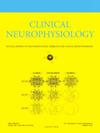增强重症肌无力的诊断敏感性:CMAP区域和振幅下降在重复神经刺激中的联合作用
IF 3.7
3区 医学
Q1 CLINICAL NEUROLOGY
引用次数: 0
摘要
目的评价CMAP面积减量和CMAP幅度减量在RNS检查中对疑似MG患者的诊断价值。方法回顾性分析2019年1月至2023年12月疑似MG患者的肌电图数据。CMAP面积和幅度下降≥10%被认为是异常的,MG的诊断是基于临床表现、抗体检测或对治疗的反应。结果共纳入204例患者。71例(29.8%)患者被诊断为MG。振幅衰减灵敏度为29.6%,面积衰减灵敏度为38%,特异度分别为99.2%和96.12%。结合这两个标准产生了43.7%的灵敏度,比单独的振幅衰减提高了14.1%。结论将CMAP面积衰减纳入RNS检测可显著提高MG的诊断敏感性,尤其是眼部病变,且不影响特异性。这种结合的方法比现有的MG诊断工具有了很大的改进,特别是在传统方法有局限性的情况下。需要进一步的研究来验证这些发现。意义本研究介绍了一种实用易行的重复神经刺激增强方法,可显著提高重症肌无力的诊断敏感性。本文章由计算机程序翻译,如有差异,请以英文原文为准。
Enhancing diagnostic sensitivity in Myasthenia Gravis: The combined role of CMAP area and amplitude decrements in repetitive nerve stimulation
Objective
To evaluate the diagnostic utility of using CMAP area decrement, in addition to CMAP amplitude decrement, in RNS testing for patients with suspected MG.
Methods
This retrospective study analyzed EMG data from January 2019 to December 2023 on patients with suspected MG. CMAP area and amplitude decrements of ≥10 % were considered abnormal, and MG diagnosis was based on clinical presentation, antibody testing, or response to treatment.
Results
A total of 204 patients were included in the final analysis. MG was diagnosed in 71 patients (29.8%). The sensitivity of the amplitude decrement was 29.6%, while the sensitivity of the area decrement was 38%, with specificities of 99.2% and 96.12%, respectively. Combining both criteria yielded a sensitivity of 43.7%, representing a 14.1% improvement over amplitude decrement alone.
Conclusion
Incorporating CMAP area decrement into RNS testing significantly enhances diagnostic sensitivity for MG, particularly in ocular forms, without compromising specificity. This combined approach presents a promising improvement over existing diagnostic tools for MG, especially in cases where traditional methods have limitations. Future research is needed to validate these findings.
Significance
This study introduces a practical and easy to adopt enhancement to repetitive nerve stimulation, significantly improving diagnostic sensitivity for Myasthenia Gravis.
求助全文
通过发布文献求助,成功后即可免费获取论文全文。
去求助
来源期刊

Clinical Neurophysiology
医学-临床神经学
CiteScore
8.70
自引率
6.40%
发文量
932
审稿时长
59 days
期刊介绍:
As of January 1999, The journal Electroencephalography and Clinical Neurophysiology, and its two sections Electromyography and Motor Control and Evoked Potentials have amalgamated to become this journal - Clinical Neurophysiology.
Clinical Neurophysiology is the official journal of the International Federation of Clinical Neurophysiology, the Brazilian Society of Clinical Neurophysiology, the Czech Society of Clinical Neurophysiology, the Italian Clinical Neurophysiology Society and the International Society of Intraoperative Neurophysiology.The journal is dedicated to fostering research and disseminating information on all aspects of both normal and abnormal functioning of the nervous system. The key aim of the publication is to disseminate scholarly reports on the pathophysiology underlying diseases of the central and peripheral nervous system of human patients. Clinical trials that use neurophysiological measures to document change are encouraged, as are manuscripts reporting data on integrated neuroimaging of central nervous function including, but not limited to, functional MRI, MEG, EEG, PET and other neuroimaging modalities.
 求助内容:
求助内容: 应助结果提醒方式:
应助结果提醒方式:


